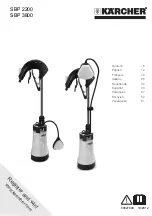
3
• Avoid dangerous environments.
Do not charge
battery pack in rain, snow, damp or wet locations.
Do not use battery pack or charger in the presence
of explosive atmospheres (gaseous fumes, dust
or flammable materials) because sparks may be
generated when inserting or removing battery pack,
possibly causing fire.
• Charge in a well ventilated area.
Do not block
charger vents. Keep them clear to allow proper
ventilation. Do not allow smoking or open flames
near a charging battery pack. Vented gases may
explode.
• Follow all charging instructions and do not
charge the battery pack or equipment outside
the temperature range specified in the instruc
-
tions.
Charging improperly or at temperatures
outside the specified range may damage the battery
and increase the risk of fire.
• A
void using an extension cord when possible.
When unavoidable, use a properly wired 16 gauge
or larger extension cord with pins that are the same
number, size and shape as the pins on the charger.
Make sure that the extension cord is in good electri
-
cal condition.
•
Unplug charger and remove battery packs
when
not in use.
• Do not burn or incinerate batteries.
Batteries may
explode. Toxic fumes and materials are created
when batteries are burned.
•
Do not use a battery pack or equipment that is
damaged or modified.
Damaged or modified bat
-
teries may exhibit unpredictable behavior resulting
in fire, explosion or risk of injury.
• Do not crush, drop, or damage battery pack.
Always securely contain battery packs during
transport.
Do not use a battery pack that has
received a sharp blow, been dropped, run over, or
damaged in any way (e.g., pierced with a nail, hit
with a hammer, stepped on, in a vehicle accident).
• Do not disassemble battery pack or charger.
If it
is damaged, take it to a MILWAUKEE service facility.
• Battery chemicals cause serious burns.
Never
allow contact with skin, eyes, or mouth. If a dam
-
aged battery pack leaks battery chemicals, use
rubber or neoprene gloves to dispose of it. If skin
is exposed to battery fluids, wash with soap and
water and rinse with vinegar. If eyes are exposed
to battery chemicals, immediately flush with water
for 20 minutes and seek medical attention. Remove
and dispose of contaminated clothing.
• Do not short circuit.
A short-circuited battery
pack may cause fire, personal injury, and product
damage. A battery pack will short circuit if a metal
object makes a connection between the positive
and negative contacts on the battery pack. Do not
place a battery pack near anything that may cause
a short circuit, such as coins, keys or nails in your
pocket.
•
Do not allow fluids to flow into battery pack.
Corrosive or conductive fluids, such as seawater,
certain industrial chemicals, and bleach or bleach
containing products, etc., can cause a short circuit.
•
Do not expose a battery pack or equipment to fire
or excessive temperature.
Exposure to fire or tem
-
perature above 265°F (130°C) may cause explosion.
• Battery packs marked as Resistant
are suit-
able for environments where incidental contact or
exposure to oils, greases, and solvents can occur.
These packs are not resistant to acids or other cor-
rosive chemicals. Never immerse or allow fluids to
penetrate the battery pack.
• Use only recommended attachments.
Use of an
attachment not recommended or sold by the battery
charger or battery pack manufacturer may result in
a risk of fire, electric shock or personal injury.
SERVICE
• Have your power supply serviced by a qualified
repair person using only identical replacement
parts.
This will ensure that the safety of the power
supply is maintained.
• Never service damaged battery packs.
Service
of battery packs should only be performed by the
manufacturer or authorized service providers.
•
Maintain labels and nameplates.
These carry im-
portant information. If unreadable or missing, contact
a MILWAUKEE service facility for a free replacement.
STORAGE
•To prevent the risk of fire or shock;
Store your
power supply and battery packs in a cool, dry
place.
Do not store where temperatures may exceed
122°F (50°C) such as
in direct sunlight, a vehicle,
or metal building during the summer.
READ AND
SAVE ALL
INSTRUCTIONS
FOR FUTURE USE.
SPECIFICATIONS
Cat. No. ..................................................... 2845-20
Battery Type
.................................................M18™
Charger Type
................................................M18™
Rated Input Voltage ................................. 120 V AC
Rated Input Amps
............................................8.4 A
Rated Output Voltage (Charger) ...................... 18 V
Rated Output Amps (Per Charger) .....................3 A
Total Rated Output (Both Receptacles)
Peak Watts
.........................3600 W for 5 seconds
Rated Watts
.............................................. 1800 W
Voltage.................................................... 120 VAC
Rated Frequency
.......................................... 60 Hz
Rated Output Voltage
(USB-A) ........................... 5VDC @ 2.1A (10.5 W)
Rated Output Voltage
(USB-C PD) ...............................20/15/12/9/5VDC
@ 3A (Up to 60 W)
Power Supply Cord................UL Listed, Type SJO,
3-conductor, No. 14 AWG min., rated 105
°
C min.,
300V/15A min., 6 ft (1.8 m) min. length
Weight (Tool Only) ............................28 lb (12.7 kg)
Weight (With four M18
™
12.0Ah battery pack) ...................41.7 lb (18.9 kg)
Recommended Ambient
Operating Temperature
....................32°F to 105°F
(0°C to 40°C)
Recommended Ambient
Charging Temperature
.....................40°F to 105°F
(5°C to 40°C)




































